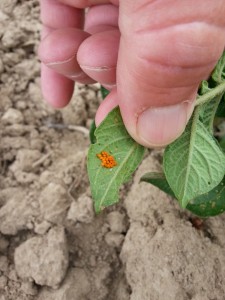Click here for more information about the Colorado Potato Beetle
Month: June 2014
Diseases Found In Tomato Plants

In this photo you will see small, darker green spots on these tomatoes. These spots are a disease called Botrytis.
Click here for more information on these diseases and a few others
Chemical Thinning In Apple Trees
Week of June 2- 6 Scout Summary
AGRONOMIC CROPS:
- Corn: Scouted fields ranged from emerging to V3 stage of development. Light slug feeding was noted on most no-till fields. Light black cutworm feeding/damage was noted on most fields with one field approaching the threshold treatment level.
- Soybeans: A lot of soybeans were planted the week of June 2 and more still to go in. Most scouted fields are just at the emerging stage of development. Some light slug feeding was noted.
- Alfalfa: Scouts noted alfalfa weevils pupating. Most alfalfa stands that have not been harvested are at 25% bloom. Scouts will be monitoring for potato leaf hopper in stands growing for 2nd cutting.
Week of June 2 – 6 Scout Summary
VEGETABLES:
- Asparagus: Scouts are noting the presence of both asparagus beetles and in some patches the number is over threshold.
- Cole crops: Cabbage, Cauliflower and Broccoli: Flea beetles have greatly increased and many cole crops had numbers over threshold, triggering a recommendation for treatment. Some imported cabbage worm larvae were noted in cabbage and broccoli.
- Onions and Garlic: Thrips are generally present but at low levels, well below threshold.
- Peas: Doing well at this time with no problems noted.
- High tunnel tomatoes: Scouts reporting tomatoes at bloom and fruit set stage of development, with some ripening. Botrytis, early blight, pith necrosis and timber rot/white mold diseases were noted by scouts. Flea beetles at low numbers were also found in some high tunnel tomatoes.
- Field tomatoes: Some beginning to bloom. Light flea beetle feeding noted.
- Sweet corn: In various fields and across planting dates ranged in size from one inch to fourteen inches in height. Some light slug damage and light cutworm damage observed by scouts in several plantings.
- Cucumbers: No pest problems noted.
- Zucchini and Summer Squash: Cucumber beetles at threshold in some fields. Scouts noted a few instances of angular leaf spot and blossom end rot on some fruit.
- Melons: Scouts noted a few cucumber beetles in some fields. Ground hog damage (eating plants) was found in a couple of fields.
- Potatoes: Both flea beetles and Colorado potato beetles (CPB) were noted at threshold levels with recommendations that growers begin rescue treatments. Scouts noted eggs, larvae and adults of CPB.
- Peppers: Most peppers had just recently been transplanted into fields and looked good. Scouts did note some light feeding by flea beetles on some plants.
- Green/Snap Beans: Most plantings looked good. A few had bean leaf beetle feeding damage at threshold level.
Week of June 2 – 6 Scout Summary
FRUIT:
- Apples: Fruit set and fruit development is progressing. Some growers are applying chemical thinning to apple trees. A second spray for codling moth should be made the week of June 9-13 based on our May 12 biofix date for codling moth. Scouts are noting some orchards with plum curculio over threshold levels. Some light levels of scab and fire blight are being noted.
- Peaches: Due to winter injury and lack of blooms and fruit set most growers do not need to spray for OFM control. There does exist a possibility that the second generation of OFM may move into nearby apple orchards and damage fruit. Beginning around 700 GDD since biofix scouts will monitor apple orchards for OFM 2nd generation flight. Currently (6-6-14) we are at approximately 575GDD since biofix
- Strawberries: Most berries are ripening and picking began in some strawberry fields this week. Scouts noted some botrytis, leaf spot and light levels of spittle bugs in some strawberry fields.
- Grapes: Scouts noted symptoms of grape black rot in some locations. Early season fungicide spray for control of grape black rot and phomopsis cane blight needs to continue. Grape berry moths continue to be caught in pheromone traps. Growers should spray for grape berry moth control the week of June 9-14.
- Brambles, Blackberries and Raspberries: Orange rust was found in some locations. Control recommendations include the removal of infected plants.
- Blueberries: Most plants are setting berries.






